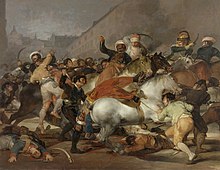The shooting of the insurgents

|
| The shooting of the insurgents |
|---|
| Francisco de Goya , 1814 |
| Oil on canvas |
| 266 × 345 cm |
The shooting of the insurgents ( Spanish El 3 de mayo en Madrid: Los fusilamientos de patriotas madrileños 'May 3rd in Madrid: The shooting of the Madrid patriots' ; also El tres de mayo de 1808 en Madrid ) is a painting by the Spanish painter Francisco de Goya . The 3.45 × 2.66 meter painting was created in 1814 and is now hanging in the Prado in Madrid .
background
The incident captured in the picture took place in 1808 in a back yard of a cathedral. Napoleon I had subdued Spain, and the royal family in Madrid had to take his orders and carry them out. On May 2, 1808, parts of the Spanish population tried by force to prevent the departure of Francisco de Paula , brother of King Fernando VII , ordered by France . The situation escalated and there was an unequal, hard fight with the French troops. The commander-in-chief of the French troops Joachim Murat declared in his order of the day:
“The misguided mob of Madrid has allowed itself to be carried away into revolt and murder. French blood has flowed. It demands vengeance. "
Any Spaniard found with a long gun was killed instantly. There were nearly 400 victims. Forty-five insurgents were rounded up on the hill of Principe Pio on the night of May 2nd and 3rd and shot. Goya took up this episode in his picture.
The paintings
Stories that 62-year-old Goya watched the execution from a distance and later ran to the place of execution with a lantern in order to capture the gloomy scenery on his sketch pad should be part of the legend; Goya had not yet lived near Principe Pio in 1808, and his picture was only taken six years later and was not a spontaneous reaction to the atrocity .
Goya presents the events on the hill of Principe Pio in a strongly contrasting form, which also reflects the imbalance of the forces in the real situation: On the one hand, the eight infantrymen of the French army, they are turned away from the viewer and form with their rifles, A soldier's coat and a high felt shako on his head literally a wall, on the other side the victims, a colorful, desperate crowd, helplessly waiting to be shot. The insurgent in the light shirt sticks out of the group. The association with Jesus Christ on the cross is deliberate, the palms of his hands have stigmas (easy to see on the right hand). Martyrs are murdered here. Goya also used this theme in his socially critical graphics The Horrors of War .
Reception of the painting
The image structure found by Goya, especially the closeness between perpetrators and victims, was taken up again several times in painting. Édouard Manet used it for his series of paintings The Execution of Emperor Maximilian of Mexico (1867–1868). In 1927 Otto Dix took up the composition again in his painting Street Fight (lost since 1945). At Dix, a group of soldiers with steel helmets shoots an angry crowd. Even Pablo Picasso used in his painting Massacre in Korea in 1951, the image construction of Goya. Yue Minjun also quotes the picture in his oil painting The Execution from 1995.
literature
- Rose-Marie Hagen , Rainer Hagen : Image surveys - masterpieces in detail . Taschen, Cologne 1994, ISBN 3-8228-6384-X .
